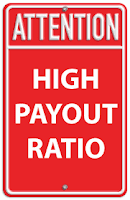The payout ratio is an often discussed metric for
determining whether a dividend payer is a solid investment. This is particularly true from a dividend
growth perspective.
The premise of the argument is that a company paying most of
its earnings in dividends doesn’t have room to increase its dividend payment
going forward. For instance, if a firm has net earnings of $3 per share per year and pays out $2.70 of those earnings in
dividends, a 90% payout ratio, it has only $0.30 per year with which to
increase dividend payments.
 |
| Danger? |
With that perspective in mind, the firms in the table below
are the Top 10 Dividend Champions by Payout Ratio on 1.31.19. All deliver 25+ year records of increasing
dividend payments while carrying the lowest payout ratio among all Dividend
Champions.
Company
|
Payout Ratio
|
Consolidated Edison
|
13.45
|
NACCO Industries
|
15.10
|
West Pharmaceutical Services
|
19.11
|
Black Hills Corp.
|
20.12
|
SEI Investments Company
|
20.95
|
Roper Technologies Inc.
|
21.07
|
Stepan Company
|
21.28
|
California Water Service
|
22.77
|
Nordson Corp.
|
23.18
|
Brown & Brown Inc.
|
23.19
|
Although this metric appears solid upon first glance, one
should also look at the dividend yield.
It’s possible a firm with a low payout ratio is paying a low dividend as
well. A good exercise here would have
been to drop another column to the right of the payout ratio in which to add
the respective yields of the firms for comparison purposes. Maybe next time.
Another item to keep in mind is that a firm with a low
payout ratio and low dividend yield, ostensibly having room to grow its
dividend, may never deliver a dividend stream as strong as that of an
alternative firm already sporting a high dividend yield and high payout
ratio. See the post on Dividend
Growth vs Dividend Yield for additional thoughts on this matter.
Buying a low payout ratio, low dividend stock might be
considered the equivalent of paying several multiples above book
value with the hope in both cases that actual results eventually meet
expectations. This can be a questionable
proposition. As a result, the Dividend
Farmer prefers to buy a bird in hand rather than two in the bush.
In any event, looking for low payout ratio dividend payers
is a popular screening method when hunting for dividend opportunities. Your investing
philosophy will help you determine whether or not emphasizing payout
ratio is right for you. Either way, it’s
a metric to keep in mind when analyzing alternatives.
The
thoughts and opinions expressed here are those of the author, who is not a
financial professional. Perspectives offered should not be considered
investment advice. They are presented for discussion and entertainment
purposes only. For specific investment advice or assistance, please
contact a registered investment advisor, licensed broker, or other financial professional.

No comments:
Post a Comment